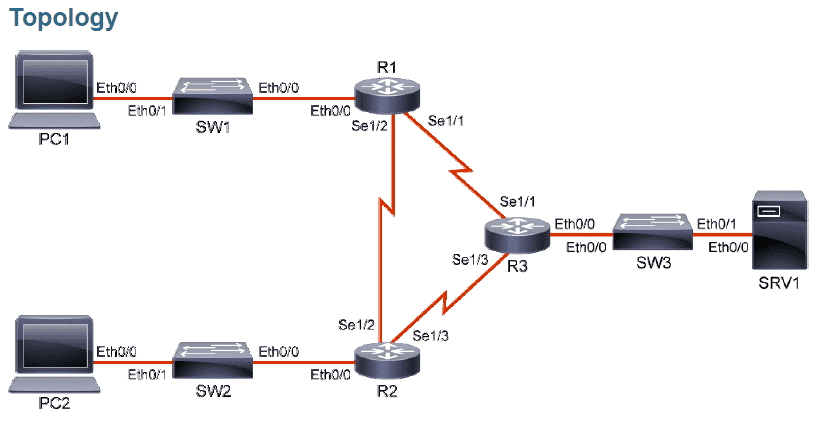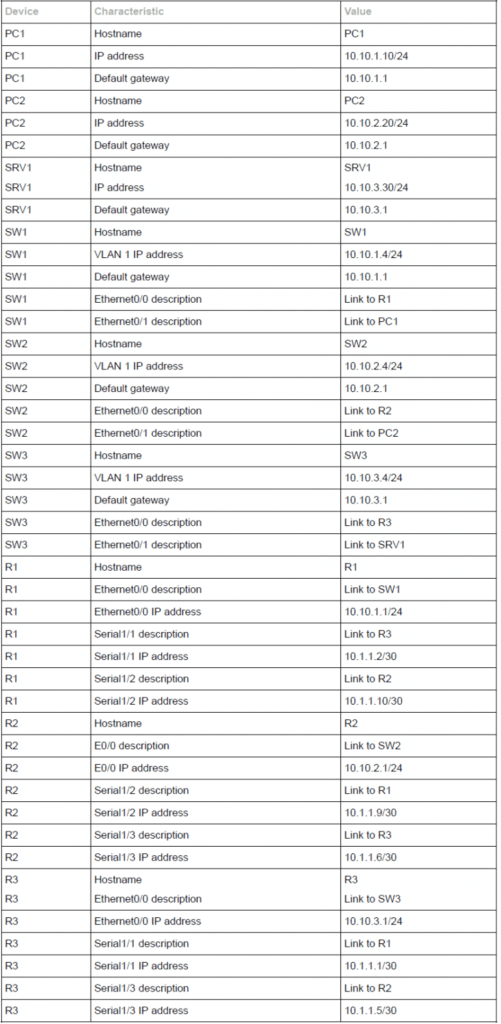Continuiamo con la nostra serie di articoli che, attraverso esempi pratici e semplificati, dimostrano l’applicazione di strumenti fondamentali nei rispettivi ambiti. Introduciamo le configurazione di base del protocollo RIPv2 su apparati Cisco. In questo laboratorio implementeremo il protocollo RIPv2 verificandone il corretto funzionamento. In estrema sintesi si configurerà RIPv2 su IPv4, agendo sui timer di default, nonché sulle opzioni di auto summarization, sul controllo degli updates sulle interfacce attraverso il “passive interface”, e sulla ridistribuzione delle rotte di default. Il laboratorio è preparato con i dispositivi come rappresentato nel diagramma della topologia e nella tabella successiva. Tutti i dispositivi hanno le loro configurazioni di base tra cui i nomi host e gli indirizzi IP. I gateway predefiniti sono configurati sugli end device PC1, PC2 e SRV1, ma nessun altra configurazione di routing è stata implementata:

Di seguito lo schema degli indirizzi che caratterizzano la topologia oggetto del laboratorio:

Sui router R1,R2 e R3 abilitiamo RIPv2 e includiamo la rete 10.0.0.0/8 nel processo del RIP:
Accediamo al Router R1 imputando i seguenti comandi:
R1# conf t
Enter configuration commands, one per line. End with CNTL/Z.
R1(config)# router rip
R1(config-router)# version 2
R1(config-router)# network 10.0.0.0
R1(config-router)# end
R1#Accediamo al Router R2 imputando i seguenti comandi:
R2# conf t
Enter configuration commands, one per line. End with CNTL/Z.
R2(config)# router rip
R2(config-router)# version 2
R2(config-router)# network 10.0.0.0
R2(config-router)# end
R2#Accediamo al Router R3 imputando i seguenti comandi:
R3# conf t
Enter configuration commands, one per line. End with CNTL/Z.
R3(config)# router rip
R3(config-router)# version 2
R3(config-router)# network 10.0.0.0
R3(config-router)# end
R3#Adesso sul Router R1 andiamo a verificare la tabella di routing verificando la presenza di molte rotte generate dal lavoro del protocollo di routing RIPv2:
R1# sh ip route
Codes: L - local, C - connected, S - static, R - RIP, M - mobile, B - BGP
D - EIGRP, EX - EIGRP external, O - OSPF, IA - OSPF inter area
N1 - OSPF NSSA external type 1, N2 - OSPF NSSA external type 2
E1 - OSPF external type 1, E2 - OSPF external type 2
i - IS-IS, su - IS-IS summary, L1 - IS-IS level-1, L2 - IS-IS level-2
ia - IS-IS inter area, * - candidate default, U - per-user static route
o - ODR, P - periodic downloaded static route, H - NHRP, l - LISP
+ - replicated route, % - next hop override
Gateway of last resort is not set
10.0.0.0/8 is variably subnetted, 9 subnets, 3 masks
C 10.1.1.0/30 is directly connected, Serial1/1
L 10.1.1.2/32 is directly connected, Serial1/1
R 10.1.1.4/30 [120/1] via 10.1.1.9, 00:00:22, Serial1/2
[120/1] via 10.1.1.1, 00:00:16, Serial1/1
C 10.1.1.8/30 is directly connected, Serial1/2
L 10.1.1.10/32 is directly connected, Serial1/2
C 10.10.1.0/24 is directly connected, Ethernet0/0
L 10.10.1.1/32 is directly connected, Ethernet0/0
R 10.10.2.0/24 [120/1] via 10.1.1.9, 00:00:22, Serial1/2
R 10.10.3.0/24 [120/1] via 10.1.1.1, 00:00:16, Serial1/1CORSI CORRELATI:
- Corso Cisco CCNA;
- Corso CCNP Enterprise ENCOR;
- Corso CCNP Enterprise ENARSI;
- Corso CCNP Enterprise ENWLSI;
- Corsi CCNP Enterprise;
- Corso Fortinet NSE4;
- Corso Huawei HCIA R&S;
Consulta il nostro Catalogo Corsi per Tecnologia oppure fai una Ricerca per Vendor o ancora trova uno specifico corso attraverso il motore di ricerca interno: Ricerca Corsi. Contattaci ora al Numero Verde 800-177596, il nostro team saprà supportarti nella scelta del percorso formativo più adatto alla tue esigenze.
Rimanendo sul Router R1 verifichiamo i timers che caratterizzano il protocollo RIPv2 nell’implementazione Cisco di default. Rileviamo i seguenti valori: Updates sono inviati ogni 30 secondi. Invalid e hold-down timers sono settati a 180 secondi. Il flush timer è impostato a 240 secondi.
R1# show ip protocols
*** IP Routing is NSF aware ***
Routing Protocol is "rip"
Outgoing update filter list for all interfaces is not set
Incoming update filter list for all interfaces is not set
Sending updates every 30 seconds, next due in 25 seconds
Invalid after 180 seconds, hold down 180, flushed after 240
Redistributing: rip
Default version control: send version 2, receive version 2
Interface Send Recv Triggered RIP Key-chain
Ethernet0/0 2 2
Serial1/1 2 2
Serial1/2 2 2
Automatic network summarization is in effect
Maximum path: 4
Routing for Networks:
10.0.0.0
Routing Information Sources:
Gateway Distance Last Update
10.1.1.9 120 00:00:01
10.1.1.1 120 00:00:17
Distance: (default is 120)Sempre sul router R1 modifichiamo l’update timer a 60 secondi lasciando tutti gli altri timers invariati:
R1# conf t
Enter configuration commands, one per line. End with CNTL/Z.
R1(config)# router rip
R1(config-router)# timers basic 60 180 180 240
R1(config-router)# end
R1#Sul Router R1, esaminiamo come è cambiata la configurazione dell’interfaccia. Dovremmo vedere il comando “ip rip advertise” sotot ogni interfaccia coinvolta nel processo di RIP. Il router imposta il comando “ip rip advertise” solo nella modalità di configurazione dell’interfaccia solo la prima volta quando il timer viene modificato dal valore predefinito:
R1# show running-config | section rip
description Link to SW1
ip rip advertise 60
description Link to R3
ip rip advertise 60
description Link to R2
ip rip advertise 60
router rip
version 2
timers basic 60 180 180 240
network 10.0.0.0Verifichiamo ancora la configurazione generale del RIP sul router R1 apprezzando il cambio del timer di update a 60 secondi:
R1# show ip protocols
*** IP Routing is NSF aware ***
Routing Protocol is "rip"
Outgoing update filter list for all interfaces is not set
Incoming update filter list for all interfaces is not set
Sending updates every 60 seconds, next due in 47 seconds
Invalid after 180 seconds, hold down 180, flushed after 240
Redistributing: rip
Default version control: send version 2, receive version 2
Interface Send Recv Triggered RIP Key-chain
Ethernet0/0 2 2
Serial1/1 2 2
Serial1/2 2 2
Automatic network summarization is in effect
Maximum path: 4
Routing for Networks:
10.0.0.0
Routing Information Sources:
Gateway Distance Last Update
10.1.1.9 120 00:00:06
10.1.1.1 120 00:00:01
Distance: (default is 120)Sul router R2 creiamo una interfaccia di loopback (int logica) assegnandole l’ip 192.168.1.5/30 e includendo questa network nel processo di RIP:
R2# conf t
Enter configuration commands, one per line. End with CNTL/Z.
R2(config)# int lo 0
R2(config-if)# ip address 192.168.1.5 255.255.255.252
R2(config-if)# router rip
R2(config-router)# network 192.168.1.0
R2(config-router)# end
R2#Ritorniamo sul router R1, interrogandolo con il comando “show ip route”. R1 è consapevole dell’esistenza della network appena configurata su R2 sulla loopback e sponsorizzata con il RIP. Ma notiamo che la rete è stata appresa nella forma classfull /24 per via dell’automatic summarization:
R1# sh ip route
Codes: L - local, C - connected, S - static, R - RIP, M - mobile, B - BGP
D - EIGRP, EX - EIGRP external, O - OSPF, IA - OSPF inter area
N1 - OSPF NSSA external type 1, N2 - OSPF NSSA external type 2
E1 - OSPF external type 1, E2 - OSPF external type 2
i - IS-IS, su - IS-IS summary, L1 - IS-IS level-1, L2 - IS-IS level-2
ia - IS-IS inter area, * - candidate default, U - per-user static route
o - ODR, P - periodic downloaded static route, H - NHRP, l - LISP
+ - replicated route, % - next hop override
Gateway of last resort is not set
10.0.0.0/8 is variably subnetted, 9 subnets, 3 masks
C 10.1.1.0/30 is directly connected, Serial1/1
L 10.1.1.2/32 is directly connected, Serial1/1
R 10.1.1.4/30 [120/1] via 10.1.1.9, 00:00:05, Serial1/2
[120/1] via 10.1.1.1, 00:00:18, Serial1/1
C 10.1.1.8/30 is directly connected, Serial1/2
L 10.1.1.10/32 is directly connected, Serial1/2
C 10.10.1.0/24 is directly connected, Ethernet0/0
L 10.10.1.1/32 is directly connected, Ethernet0/0
R 10.10.2.0/24 [120/1] via 10.1.1.9, 00:00:05, Serial1/2
R 10.10.3.0/24 [120/1] via 10.1.1.1, 00:00:18, Serial1/1
R 192.168.1.0/24 [120/1] via 10.1.1.9, 00:00:05, Serial1/2Ritorniamo sul router R2 disabilitando l’automatic summarization:
R2# conf t
Enter configuration commands, one per line. End with CNTL/Z.
R2(config)# router rip
R2(config-router)# no auto-summary
R2(config-router)# end
R2#
Ritorniamo sul Router R1 e interrogando la tabella di routing, notando che la rete 192.168.1.4/30 è ora annunciata cosi com’è. Ritroviamo anche la rete 192.168.1.0/24 annunciata dal Router R3 che ancora applica l’automatic summarization. Se volessimo non rilevare più questa rotta summarizata dovremmo disabilitare l’automatic summarization anche sul Router R3:
R1# sh ip route
Codes: L - local, C - connected, S - static, R - RIP, M - mobile, B - BGP
D - EIGRP, EX - EIGRP external, O - OSPF, IA - OSPF inter area
N1 - OSPF NSSA external type 1, N2 - OSPF NSSA external type 2
E1 - OSPF external type 1, E2 - OSPF external type 2
i - IS-IS, su - IS-IS summary, L1 - IS-IS level-1, L2 - IS-IS level-2
ia - IS-IS inter area, * - candidate default, U - per-user static route
o - ODR, P - periodic downloaded static route, H - NHRP, l - LISP
+ - replicated route, % - next hop override
Gateway of last resort is not set
10.0.0.0/8 is variably subnetted, 9 subnets, 3 masks
C 10.1.1.0/30 is directly connected, Serial1/1
L 10.1.1.2/32 is directly connected, Serial1/1
R 10.1.1.4/30 [120/1] via 10.1.1.9, 00:00:03, Serial1/2
[120/1] via 10.1.1.1, 00:00:22, Serial1/1
C 10.1.1.8/30 is directly connected, Serial1/2
L 10.1.1.10/32 is directly connected, Serial1/2
C 10.10.1.0/24 is directly connected, Ethernet0/0
L 10.10.1.1/32 is directly connected, Ethernet0/0
R 10.10.2.0/24 [120/1] via 10.1.1.9, 00:00:03, Serial1/2
R 10.10.3.0/24 [120/1] via 10.1.1.1, 00:00:22, Serial1/1
192.168.1.0/24 is variably subnetted, 2 subnets, 2 masks
R 192.168.1.0/24 [120/2] via 10.1.1.1, 00:00:22, Serial1/1
R 192.168.1.4/30 [120/1] via 10.1.1.9, 00:00:03, Serial1/2Ora sul R3 verifichiamo quali interfacce inviino gli update del RIP. Rileviamo che le tutte le interfacce configurate nel range IP 10.0.0.0/8 sono coinvolte nel processo:
R3# sh ip prot
*** IP Routing is NSF aware ***
Routing Protocol is "rip"
Outgoing update filter list for all interfaces is not set
Incoming update filter list for all interfaces is not set
Sending updates every 30 seconds, next due in 17 seconds
Invalid after 180 seconds, hold down 180, flushed after 240
Redistributing: rip
Default version control: send version 2, receive version 2
Interface Send Recv Triggered RIP Key-chain
Ethernet0/0 2 2
Serial1/1 2 2
Serial1/3 2 2
Automatic network summarization is not in effect
Maximum path: 4
Routing for Networks:
10.0.0.0
Routing Information Sources:
Gateway Distance Last Update
10.1.1.2 120 00:00:10
10.1.1.6 120 00:00:18
Distance: (default is 120)Facciamo la stessa verifica sul R2 rilevando numerose interfacce sul quale sia attivo il RIP nonostante sia del tutto inutile (Ethernet0/0 and Loopback0). Quindi ci serviamo del comando “passive-interface” per regolamentare su queli interfacce voler inviare gli update del processo RIPv2. Nello specifico procediamo a impostare il passive-interface su tutte le interfacce per poi riabilitare le Interfacce seriali, dove gli update sono necessari:
R2# sh ip protocols
*** IP Routing is NSF aware ***
Routing Protocol is "rip"
Outgoing update filter list for all interfaces is not set
Incoming update filter list for all interfaces is not set
Sending updates every 30 seconds, next due in 23 seconds
Invalid after 180 seconds, hold down 180, flushed after 240
Redistributing: rip
Default version control: send version 2, receive version 2
Interface Send Recv Triggered RIP Key-chain
Ethernet0/0 2 2
Serial1/2 2 2
Serial1/3 2 2
Loopback0 2 2
Automatic network summarization is not in effect
Maximum path: 4
Routing for Networks:
10.0.0.0
192.168.1.0
Routing Information Sources:
Gateway Distance Last Update
10.1.1.10 120 00:00:39
10.1.1.5 120 00:00:15
Distance: (default is 120)
R2# conf t
Enter configuration commands, one per line. End with CNTL/Z.
R2(config)# router rip
R2(config-router)# passive-interface default
R2(config-router)# no passive-interface Serial 1/2
R2(config-router)# no passive-interface Serial 1/3
R2(config-router)# end
R2#Torniamo a verificare da quali interfacce il router R2 stia effettivamente inviando update RIP e rileviamo che effettivamente sono inviate solo dalle interfacce seriali:
R2# sh ip protocols
*** IP Routing is NSF aware ***
Routing Protocol is "rip"
Outgoing update filter list for all interfaces is not set
Incoming update filter list for all interfaces is not set
Sending updates every 30 seconds, next due in 26 seconds
Invalid after 180 seconds, hold down 180, flushed after 240
Redistributing: rip
Default version control: send version 2, receive version 2
Interface Send Recv Triggered RIP Key-chain
Serial1/2 2 2
Serial1/3 2 2
Automatic network summarization is not in effect
Maximum path: 4
Routing for Networks:
10.0.0.0
192.168.1.0
Passive Interface(s):
Ethernet0/0
Ethernet0/1
Ethernet0/2
Ethernet0/3
Serial1/0
Passive Interface(s):
Serial1/1
Loopback0
RG-AR-IF-INPUT1
VoIP-Null0
Routing Information Sources:
Gateway Distance Last Update
10.1.1.10 120 00:00:05
10.1.1.5 120 00:00:09
Distance: (default is 120)Per concludere questo laboratorio impostiamo sul Router R3 il comando “default-information originate” che permetterà a R3 di sponsorizzare agli altri router le default route di cui è dotato. Verifichiamo quindi nel Router R1 che la rotta di default si sia effettivamente propagata:
R3# conf t
Enter configuration commands, one per line. End with CNTL/Z.
R3(config)# router rip
R3(config-router)# default-information originate
R3(config-router)# end
R3#
R1# sh ip route
Codes: L - local, C - connected, S - static, R - RIP, M - mobile, B - BGP
D - EIGRP, EX - EIGRP external, O - OSPF, IA - OSPF inter area
N1 - OSPF NSSA external type 1, N2 - OSPF NSSA external type 2
E1 - OSPF external type 1, E2 - OSPF external type 2
i - IS-IS, su - IS-IS summary, L1 - IS-IS level-1, L2 - IS-IS level-2
ia - IS-IS inter area, * - candidate default, U - per-user static route
o - ODR, P - periodic downloaded static route, H - NHRP, l - LISP
+ - replicated route, % - next hop override
Gateway of last resort is 10.1.1.1 to network 0.0.0.0
R* 0.0.0.0/0 [120/1] via 10.1.1.1, 00:00:04, Serial1/1
10.0.0.0/8 is variably subnetted, 9 subnets, 3 masks
C 10.1.1.0/30 is directly connected, Serial1/1
L 10.1.1.2/32 is directly connected, Serial1/1
R 10.1.1.4/30 [120/1] via 10.1.1.9, 00:00:13, Serial1/2
[120/1] via 10.1.1.1, 00:00:24, Serial1/1
C 10.1.1.8/30 is directly connected, Serial1/2
L 10.1.1.10/32 is directly connected, Serial1/2
C 10.10.1.0/24 is directly connected, Ethernet0/0
L 10.10.1.1/32 is directly connected, Ethernet0/0
R 10.10.2.0/24 [120/1] via 10.1.1.9, 00:00:13, Serial1/2
R 10.10.3.0/24 [120/1] via 10.1.1.1, 00:00:24, Serial1/1
192.168.1.0/24 is variably subnetted, 2 subnets, 2 masks
R 192.168.1.0/24 [120/4] via 10.1.1.9, 00:00:13, Serial1/2
R 192.168.1.4/30 [120/1] via 10.1.1.9, 00:00:13, Serial1/2

